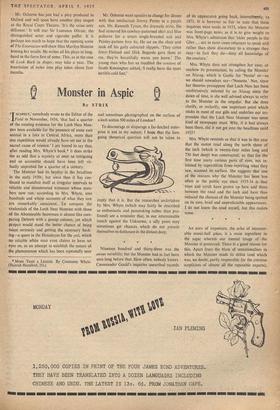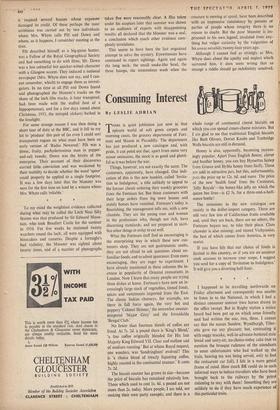Monster in Aspic By STR1 X • suseEcT,' somebody wrote
to the Editor of the Field in November, 1934, 'that had a quarter of the existing evidence for the Loch Ness Mon- ffter been available' for the presence of some rare animal in a lake in Central Africa, more than one expedition would already have set out in the sacred cause of science.' I am bound to say that, after reading Mrs. Whyte's book,* it does strike me as odd that a mystery at once so intriguing and so accessible should have been left vir- tually unprobed for a quarter of a century.
The Monster had its heyday in the headlines in the early 1930s; but since then it has con- tinued to manifest itself at irregular intervals to reliable and 'disinterested witnesses whose num- . hers now run, according. to Mrs. Whyte, into hundreds and whose accounts of what they saw are remarkably ' consistent. To compare the credentials of the Loch Ness Monster with those of the Abominable Snowman is almost like com- paring Debrett with a gossip column; yet which project• would stand the better chance of being taken seriously and getting the necessary back- ing—a quest in the Himalayas for the yeti, which no reliable white man even claims to have set eyes on, or an attempt to establish the nature of the phenomenon which has been repeatedly seen * MORE THAN A LEGEND. By Constance Whyte. (Hamish Hamilton, 21s.) and sometimes photographed on the surface of a loch within 500 miles of London?
To discourage or disparage a far-fetched enter- prise is not in my nature; I hope that the fore- going rhetorical question will not be taken to imply that it is. But the researches undertaken by Mrs: Whyte (which may fairly be described as enthusiastic and painstaking rather than pro- found) are a reminder that, in our interminable match against the Unknown, a silly point may sometimes get chances which do not present themselves to fieldsmen in the distant deep.
*.
Nineteen hundred and thirty-three was the annus mirabilis; but the Monster had in fact been seen long before that. How often, nobody knows. Commander Gould's inquiries unearthed records of its appearance going back,. intermittently, to 1871. It is however as fair to note that these inquiries were made in 1933, when the Monster was front-page news, as it is to give weight to Mrs. Whyte's admission that 'older people in the Glen ... are in most cases reluctant to speak and rather than show discourtesy to a stranger they may--in fact they do—deny all knowledge of the creature.'
Mrs. Whyte does not strengthen her case, or anyhow its presentation, by calling the Monster an Niseag, which is Gaelic for 'Nessie' or—as we should nowadays say—'Nessette.' Nor, since her theories presuppose that Loch Ness has been unobtrusively infested by an Niseag since the dawn of time, is she well advised always to refer to the Monster in the singular. But she does clarify, or reclarify, one important point which sticks in most of our gills and underlies our im- pression that the Loch Ness Monster was some kind of newspaper stunt. Why, if it had always been there, did it not get into the headlines until 1933?
Mrs. Whyte reminds us that it was in this year that the motor road along the north shore' of the loch (which is twenty-four miles long and 750 feet deep) was constructed; so that for the first time many curious pairs of eyes, not in- hibited by superstition from reporting what they *saw, scanned its surface. She suggests that one of the reasons why the' Monster has been less often in the public eye since 1933-34 is -that trees and scrub have grown up here and there between the road and the loch and have thus reduced the chances of the Monster being spotted on its rare, brief and unpredictable appearances_ I do not know the road myself, but this makes sense.
* * * An aura of imposture, the echo of innumer- able music-hall jokes, is a main ingredient in the aspic wherein our mental image of the Monster is preserved.'There is a good reason for this. Apart from the blaze of sensationalism in which the Monster made its ddbut (and which was, no doubt, partly responsible for the extreme scepticism of almost all the reputable experts), it inspired several hoaxes whose exposure damaged its credit. Of these perhaps the most ambitious was carried out by two individuals whom Mrs. Whyte calls Pilt and Down and whom, as it happens, I remember meeting at the time.
Pilt described himself as a big-game hunter, was a Fellow of the Royal Geographical Society and had something to do with films; Mr. Down was a less colourful but quicker-witted character with a Glasgow accent. They induced a national newspaper (Mrs. Whyte does not say, and I can- not remember, which) to engage them as investi- gators. In no time at all Pilt and Down found and photographed the Monster's tracks on the shore of the loch (the tracks, it later transpired, had been made with the stuffed foot of a hippopotamus), and for a few days round about Christmas, 1933, the intrepid shikaris bathed in the limelight.
For some strange reason I was then doing a short tour of duty at the BBC, and it fell to my lot to 'produce' this pair of (as even I could see) transparent rogues on what must have been an early version of `Radio Newsreel.' Pilt was a dense, fruity, pachydermatous man in pepper- and-salt tweeds; Down was the brains of the enterprise. Their account of their discoveries carried little conviction and was weakened by their inability to decide whether the word 'spoor' could properly be applied to a single footprint. It was a few days later that the Monster was seen for the first time on land by a witness whom Mrs. Whyte calls `reliable.'
* *
To my mind the weightiest evidence collected during what may be called the Loch Ness Silly Season was that produced by Sir Edward Moun- tain, who took Beaufort Castle for the summer in 1934. For five weeks he stationed twenty watchers round the loch; all were equipped with binoculars and cameras. Despite a fortnight's bad visibility, the Monster was sighted about twenty times, and of a number of photographs taken live were reasonably clear. A film taken under his auspices later that summer was shown to an audience of experts with disappointing results; all declared that the Monster was a seal, a conclusion which much other evidence com- pletely invalidates.
This seems to have been the last organised attempt to solve the mystery. Eyewitnesses have continued to report sightings. Again and again the long neck, the small snake-like head, the three humps, the tremendous wash when the creature is moving at speed, have been described with an impressive consistency by persons or parties of people whose integrity there is no reason to doubt. But the poor Monster is im- prisoned in his own legend, insulated from any- thing but vulgar curiosity by the vulgarities of his minus mirabilis twenty-four years ago.
Although I cannot feel as strongly as Mrs. Whyte does about the apathy and neglect which surround him, it does seem wrong that so strange a riddle should go indefinitely unsolved.













































 Previous page
Previous page